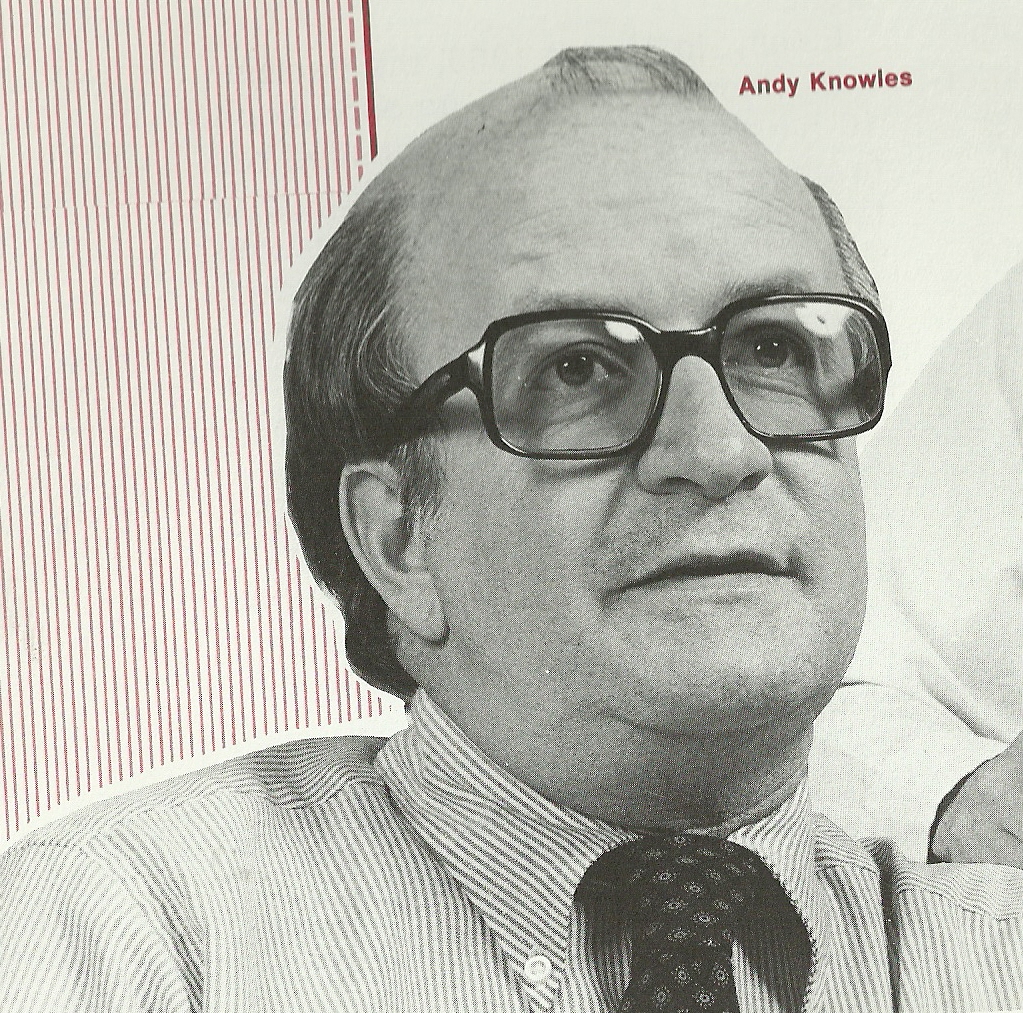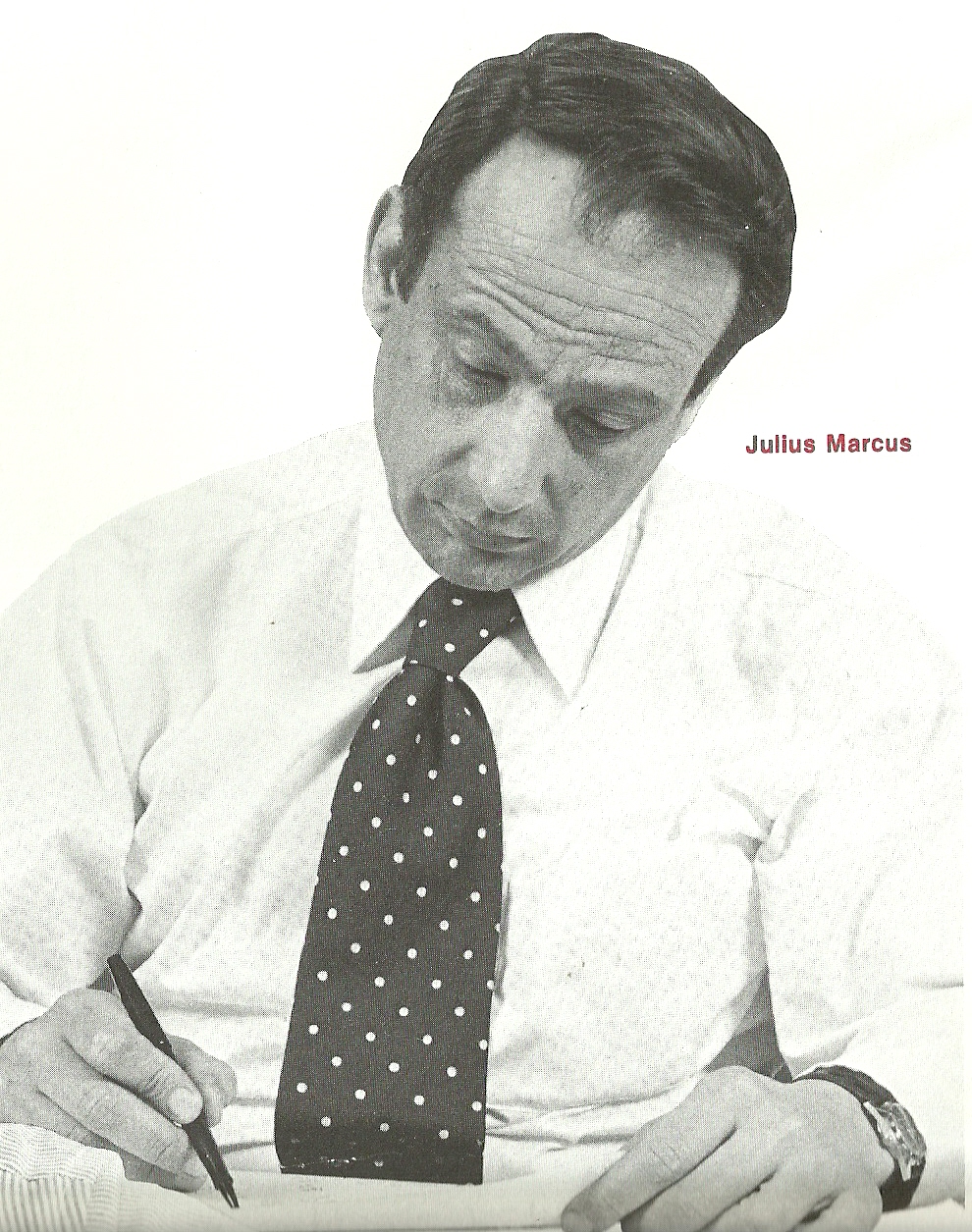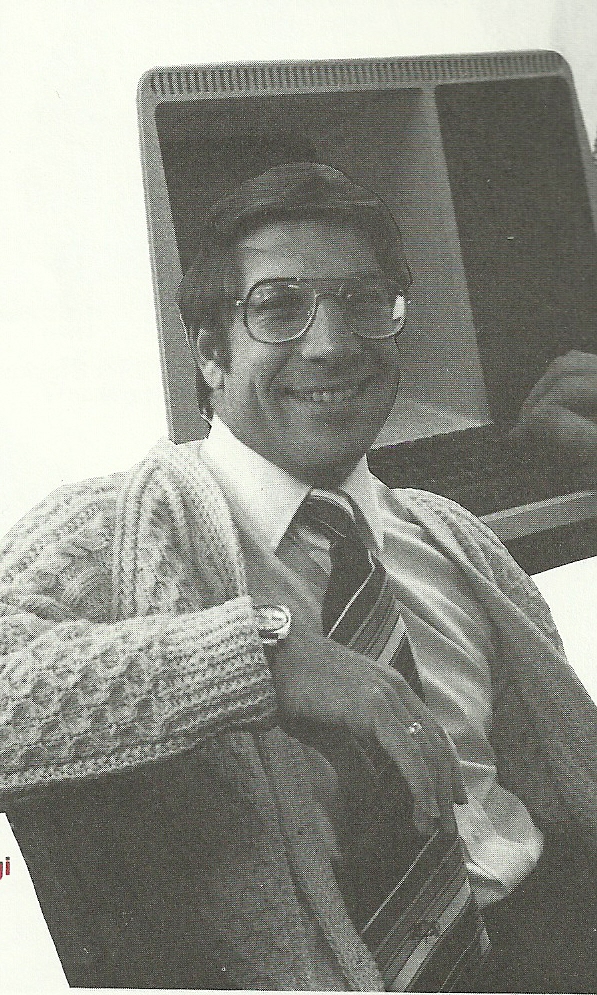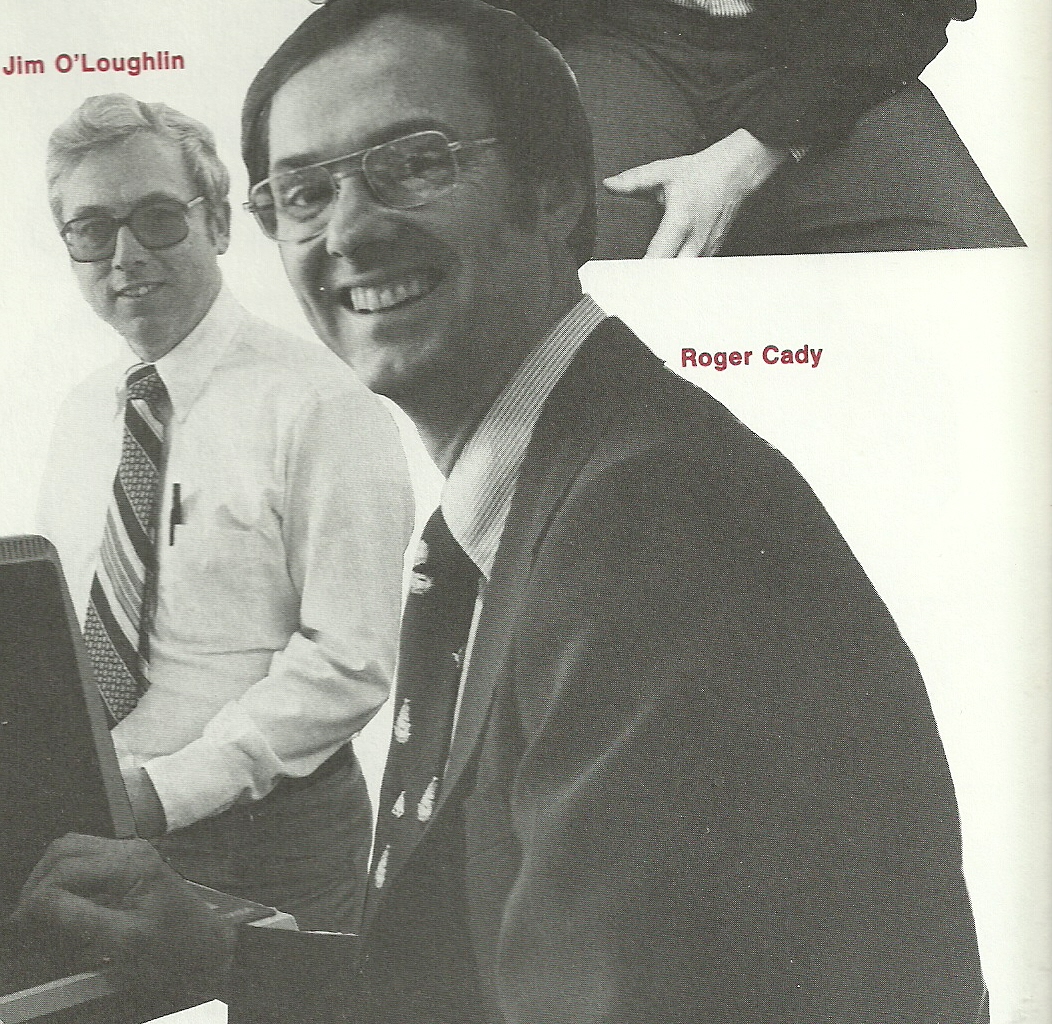Richard Seltzer's home page
Publishing home
Articles about DEC
PDP-11: All Out to Win (Tenth Anniversary of a Computer Family)
by Richard Seltzer, from
DECWORLD, the Company Newspaper, May 1980
The year was
1969, the 12-bit PDP-8 was the minicomputer, and DEC was the
PDP-8 company.
Several firms
had already introduced 16-bit machines, and customers were
anxiously awaiting DEC's answer to the competition. Internally,
there was an understandable resistance to a product that might
displace PDP-8 business.
The prospect
of a 16-bit computer had been discussed for several years. In
fact, two projects had been started. The first was abandoned
because it failed to meet cost goals. The second, code-named DCM
(Desk Calculating Machine), had run into design problems.
Two central
processors -- an 8-bit and a 16-bit -- were partially designed.
An 8-bit memory was ready for release. Software was under way.
Packaging had been designed. A common data bus would tie
together central processor, core memory and peripherals as
system units that could easily be replaced or added to. But the
processor design was not crystallizing. Benchmarks were run and
instructions added; one change led to another and another, with
no end in sight.
Finally, in
March 1969, the decision was made to switch to an entirely new
16-bit architecture that simplified programming and took full
advantage of the common data bus which became the UNIBUS. Work then proceeded at
a frenzied pace to get a machine ready for market. DEC was
coming from behind. The pressure was on.
In April 1970,
a little over a year after adoption of the new design, DEC
delivered its first PDP-11 -- not just another 16-biot computer,
but the start of a family would grow at a phenomenal pace. Now
in its fourth generation, the PDP-11 has set standards of
performance and reliability for the minicomputer industry and
has transformed the company. Due in large part to the success of
the PDP-11, DEC has grown 20-fold over the last 10 years.
Design born in March
Although small
in comparison with today, DEC, in 1969, was the world's leading
minicomputer manufacturer. It had a well-established reputation,
nearly $100 million in revenues and about 4000 employees
worldwide. That spring only a couple dozen people in a corner of
the Mill were working on the PDP-11, just one project among many
that were then in development.
About
Christmas 1968, Roger Cady had taken over the DCM project from
John Cohen and renamed it "PDP-11". Hal McFarland and Bev Young,
key engineers, were already in place. Cady brought in Jim
O'Loughlin to help develop the central processor, Paul Janson to
work on the UNIBUS and peripherals and Ken Hedberg to get things
done. He also invited Bruce Delagi, Rick Merrill and others to
consult on the architecture.
"McFarland had
proposed a completely different architecture for the instruction
set processor. Time
was important; it seemed too late to make such a wholesale
change. On the other hand, the architecture we had was not
working out." Cady recalls.
So one snowy
Sunday morning, March 9, 1969, Cady, O'Loughlin, McFarland and
Merrill flew to Pittsburgh to meet with Gordon Bell and Bill
Wulf, professors at Carnegie-Mellon. Bell had been consulting on
the DCM project, and McFarland was a former student of his. The
consensus of that Sunday meeting was to go with the new
architecture proposed by McFarland, a decision later ratified by
the Operations Committee in Maynard.
"We wanted an
architecture that would last. So in the course of about a week,
we decided to discard about a year's worth of work," O'Loughlin
remembers.
Dave Nevala
and Chuck Blasi were making progress on the packaging.
Programmers under Hank Spencer and John Hittlell were busy
writing system and diagnostic software. Bob Hamel and Pete
Durant were working on memory. With the new design, most of them
had to turn around and start all over.
O'Loughlin
worked all spring on logic design of the central processor while
others tuned up the instructions and made final changes in the
UNIBUS.
Bell had
advocated the use of a single bus architecture as opposed to the
separated bus structures that had been used in all previous
computers. This
concept, embodied in the UNIBUS, was an important part of the
compute. The first single data bus to enable minicomputer
devices to send, receive or exchange data without processor
intervention, the UNIBS provided an unexpected bonus for the
design team. It gave an interface specification for each piece
of the system. This meant that memory, peripheral and central
processor development could all proceed independently and in
parallel. "That enabled us to go faster, to deliver system units
modularly and expand as we went along," explains Cady.
By April3,
Cady had sketched out plans for a family of eight machines,
cover a wide performance range.
Suddenly, the
project shifted gears. "Sooner or later you have to stop
designing or you never get products," explains Cady. "You have
to say, 'No more discussion. Enough inventing. Now we product.'"
Starting from
a brand new design in march, the team produced experimental wire
wrapped models of the PDP-11/20, the first member of the family,
that summer; printed circuit prototypes that fall and machines
ready for delivery to customers the following April
"We did in 13
months what now takes 18 months in two years," notes O'Loughlin.
There was a
great deal more informally 10 years ago, said Bob Puffer, then
in charge of manufacturing engineering. There was very little
stratification of effort. managers were designing, technicians
were designing, designers were managing and everybody was
expediting. Jobs wee parceled out to people who had time.
Relatively little was systematized or written down. Much
happened verbally in face-to-face conversations -- people walked
around with engineering notebooks under their arms, had
impromptu meetings in hallways, jotted own notes and went off to
make things happen.
Engineers
wrote their own component specifications, Cady remembers.
Drafting, printed circuit layout, the board shop and other
support operations were all near at hand int he Mill so it was
relatively easy to get things done and make changes.
On the other
hand, proximity to manufacturing meant noise. the DCM group had
been up in Mill 5-5, trying to design to the tune of
wire-wrapping guns on the PDP-9 production line. Cady moved the
group down to 5-2 -- somewhat quieter, even though it was right
below the loading dock.
Tom Karpowski
became Field Service's product support manager for the PDP-11,
and technicians from Field Service and Quality Control joined
the engineering team, not just to look after the interests of
their groups but to help design, build and debug the breadboards
and prototypes. For the debugging process, the whole team went
on a three shift basis; but even at that, 60- and 70-hour weeks
were common.
The Operations
Committee kept close watch on every move. Design reviews were
held in Ken Olsen's office. The company was committed to
producing this computer and getting it to market rapidly.
Despite time
pressure the PDP-11 engineering group championed changes int he
company's design and manufacturing practices to make the product
economical to manufacture and service.
In particular,
to implement the modular concept (system units tied together by
the UNIBUS), the designers opted for what were then considered
large densely packed printed circuit boards.
The company
had previously built computers using backplane wiring and
standard flip-chip logic cards. The PDP-11 group used that
technique to build the first working models. Then, module by
module, as the design checked out, bulky assemblies of those
standard cards were replaced with dedicated printed circuit
boards etched specifically for the PDP-11. The computer kept
getting smaller and smaller. By the time it was done, the entire
PDP-11/20 fit into a box 10-1/2" high -- about 1/12 the size of
the original mock-up.
Memory cores
were put down flat on large boards, and wire were run through in
one pass rather than stacked in layers then wired together.
Advances such as this helped significantly to reduce hardware,
assembly and service costs.
The circuit
boards presented another challenge to manufacturing, which was
set up to produce flip-chip modules a quarter their size with
wider circuit lines. But changes that seemed drastic at the time
soon after became the accepted norm.
Such
innovation has always been a part of the process at DEC, says
O'Loughlin.
The PDP-11
represented a totally new computer architecture. It required new
peripherals, new system software, new diagnostic software, new
manufacturing procedures. The UNBUS made it possible to
introduce the PDP-11/20 with a minimal hardware configuration.
Options could be added later.
Introduction
was scheduled for early January 1970, and the company still had
to gear up in dozens of ways to get ready to make market and
service this new line of products.
In late August
1969, Julius Marcus joined the company as PDP-11 marketing
manager. "I had been with the company only two days when I was
told to go before the Operations Committee with a proposal to
price the PDP-11," he remembers. "I had just a week to come up
with a price list and documentation to justify it relative to
the competition."
In September,
Tom MacDonald came on board as the production engineer
responsible for introducing the PDP-11 into manufacturing. Almost immediately,
before the final designs had been released, he had to make
commitments for shipments that were a year away -- otherwise
materials, equipment and people would not be in place when they
were needed.
PDP-11 patents
Although DEC, in 1969, was not very patent-conscious,
Andy Knowles convince the company to file for patents on the
PDP-11 because of the computer's unique design and market
potential.
Four basic
patents cover the whole PDP-11 family, including the LSI-11.
(The company has other patents on specific models, but these
four apply to all models.)
Processor
Design (two): 1. Hal McFarland and Jim O'Loughlin, investors; 2.
Bruce Delagi, Hal McFarland and Jim O'Loughlin, inventors
UNIBUS and
UNIBUS Peripherals (two): John Cohen, Paul Janson, Hal
McFarland, and James (Bev) Young, inventors for both.
Debut in January
Andy Knowles joined as product line manager in November
1969. He arranged weekly meetings of all those involved --hardware
engineering, software engineering, diagnostics, marketing,
manufacturing and field service. All worked closely together,
helping one another to get things done quickly with what, today,
would seem like minimal resources.
Engineering,
marketing and diagnostics were all on the same floor, Mill 5-2.
Field service was intimately involved, with Andy Verostic, in
particular, not only helping debug prototypes but also
contributing to the design. Systems software was in close touch,
suggesting -- and getting -- changes in the hardware design.
Although the
product had tremendous potential for expansion, it would be a
year or two, at best before a full complement of options would
be available. In the meantime, it would have to be sold with
just 4K or 8K words of core memory, some rudimentary paper tape,
software, a Teletype, a paper tape reader and punch. And, it
would be in competition with more elaborate systems already in
production for a year or more.
"The
challenge," according to Marcus, "was to make this product look
unique."
The potential
of this new family of computers was emphasized -- the UNIBUS and
the new architecture with its large address size, easy
interfacing and easy programming.
The original
press release, sent out Jan. 2, 1970, boasted that because of
the UNIBUS, the PDP-11 would change the concept of computer
obsolescence: "...the UNIBUS offers a customer a new approach to
computer expandability as well as extending computer life almost
indefinitely."
The sales
force considered the PDP-11 a very complicated computer. To
attack this problem, Marcus did two things. He sent Jim Davis to
the regions and larger districts to give sales representatives
two-day courses on the PDP-11. He also asked for 10 hand-picked
salesmen, at least one for every region, and brought them in for
special training. NO equipment was available at the time, so he
had to make do with audiovisuals.
"As PDP-11
sales specialist of the Central Region, I was like a roving
ambassador," Gale Morgan remembers. "I would be called in to
make a customer presentation and then go on my merry way."
Morgan, now
Western Region manager, made the first quantity sale -- 25
machines to Applied Dynamics in Ann Arbor, Mich. "I remember
talking about the 'family of machines.' Every time I'd say that,
somebody would ask, 'Well, what are the next machines going to
look like?" I had no idea. 'Are they going to be bigger or
smaller?' 'I don't know, but it's going to be a great family of
machines.' Every time somebody would bump e, I'd say, 'great
family of machines.'"
Dezi Dezzani
who made one of the first sales to MB Electronics in New Haven,
Conn., recalls: "We were selling against real hardware, and all
we had to show was paper. The customer had to have a great deal
of confidence in DEC and our ability to come through," and many
did.
By the end of
the first week after the introduction, the company received 150
orders for PDP-11/20s. By March, the product line had booked its
first two $1 million orders -- 100 computers for CMC in Canada
and 10 systems for Sundstrand in Chicago.
In those early
days, engineers frequently went along to help on sales calls.
"Some customers thought the PDP-11/20 was slow because the
instructions cycle time was slow," said Tom Stockebrand,
engineering manager for communications. "But the instructions
were powerful enough that you needed lots fewer of them. You had
to teach that to customers."
In spring
1970, Stockebrand came over from process engineering to design
communications products for the PDP-11. His group, including
Vince Bastiani, quickly developed a series of modules that
interfaced between the UNIBUS and telephone equipment.
Such hardware
and corresponding software helped open up a whole new
marketplace in distributed networks and communications, Cady
said.
By April, when
the first two systems were delivered to customers, dozens of
PDP-11 development projects were under way. From May until
November that year, the company announced 17 new products
related to the PDP-11. Options were being released so fast that
price lists were incomplete by the time they were printed.
Demand for
information was so great that system manuals were released in
rough form to get them out early and published later in final
form.
"We thought
10,000 PDP-11/20 handbooks would take care of us forever,"
Marcus recalled. "In just two or three years, we distrusted over
300,000."
Teamwork makes it possible
Manufacturing
had been supporting engineering since early fall, and
engineering, in turn, supported manufacturing, said Tom
MacDonald, senior production engineer. Well past the initial
shipments of systems, the two groups worked together as a single
project team.
To save time
on the first two shipments, manufacturing built the boards and
the sheet metal, and engineering assembled and debugged the
systems. Meanwhile Ron LaFosse set up a pilot production line in
Mill 1-5.
Field Service
technicians who would have to install and service early
shipments got on-the-job training by helping manufacturing gear
up for production. The Westfield plant, where the production
line would ultimately move, also sent representatives to Maynard
for training.
In June, the
first month of production, 97 computers were shipped -- "within
three of the 100-system schedule established over six months
ago," noted Bob Puffer, in a memo commemorating the event. In
July, over $1 million worth of PDP-11s were shipped.
By Nov. 3, the
entire production line had moved to the newly-opened Westfield
facility. Even then the product line stayed in close touch with
manufacturing, through monthly steering committee meetings in
Westfield.
Family adds new members
In the fall
of 1970, the second member of the family, the PDP-11/15, a scaled
down version of the PDP-11/20 was announced. And an engineering
group under Dick Clayton was well along in development of the
third member, the PDP-11/45, a much faster and more powerful
machine.
Also that
fall, the family's first operating system DOS (Disk Operating
System) became available, making it possible to use peripherals
besides paper tape (e.g., DECtape, a fixed head disk or a
removable disk).
The original
software had consisted of just a few paper tape utilities -- an
assembler, a loader, an editor and a rudimentary operating
executive. Since prototypes were not available, programmers had
to use a simulation on a PDP-10.
"We weren't
able to do much work," system programmer Roger Willis recalls.
"The simulator was written in FORTRAN an used so much of the
large machine's resources that only one programmer could use it
at a time."
By the summer
of 1970, the DOS development team had its own PDP-11/20 but
still needed to use the simulator on the PDP-10. The tam offices
were in Mill 12-2, the computer lab was in the lobby of Mill
12-1 and the PDP-10 in the basement of Mill 5, according to
another systems programmer, Louis Cohen.
"We would work
at our desks, figure out what changes we wanted to make in the
program, run downstairs to the PDP-10 terminals to edit files,
run up to Mill 12-3, all the way across Mill 3 to Mill 5, down
to the basement to get the listing and the paper tape; then come
all the way back to our desks, figure out what we had done, go
back downstairs and try the paper tape on the PDP=11/20," Cohen
said.
A year after
the product introduction, the U.S. economy slipped into a
recession, but the PDP-11 was strong. "We would not have been as
successful as we were if we had been a year later. Timing was
critical," said Cady. "As it turned out, we had a backlog and
heavy demand for a unique product during that recession. We kept
moving."
Not only did
the PDP-11/20 sell, but customers kept ordering larger and more
expensive systems than anticipated.
The product
line had expected heavy demand for inexpensive basic units --
PEP-11/20s with 4K words of memory and an even small computer
announced at the same time -- a dedicated controller called the
PDP11/10. As it turned out, customers ordered large rather than
small PDP-11/20s and the PDP-11/10 was never shipped. (Two years
later, another PDP-11/10 -- entirely distinct from the first --
was announced.)
"I remember we
used to have raging arguments over what the average size of a
system would be," said Pete Durant. "Some people said, "You'll
never need more than 4K words of memory," Others said, "We're
going to go to 8K someday." The first year, the average system
was over 8K."
Because of the
expected heavy sales of small, basic computers, systems
programming had squeezed DOS into a very small space -- just 1K
of memory, John Sosville remembers. the effort required
tradeoffs, ingenuity and lots of time.
"It was like
packing all you need for a vacation into a briefcase only to
find out later that you could have used a trunk," Sosville said.
Software
development manager Hank Spencer continued: "When systems began
to et much bigger and memory prices began to drop, there were
inefficiencies inherent in DOS that we could not get around
anymore. It would have been considerably more efficient had we
designed for a larger machine int he first place.:
As it turned
out, PDP-11 business simply did not follow the pattern of PDP-8
business. Customers
bought larger systems for larger jobs. In fact, the PDP-11 did
not simply replace the PDP-8, as many had expected it would, but
rather opened new markets, new applications. In terms of units
shipped, the PDP-8 business continued and still continues to
grow, notes Marcus.
In 1970, a
basic PDP-11/20 would fill about half a bay, but within a couple
of years, customers were ordering systems with six or seven bays
of peripherals.
"We were
surprised. Customers recognized the value of the machine much
faster than we expected," admits Marcus. "We were selling the
PDP-11 as a simple product and customers were buying it as a
complex product. That led us to change direction. We had to
learn to engineer, build and service large computer machines."
Focus shifts to
applications
"We
believed the market was only limited by our ability to do a good
job for our customers," Andy Knowles said. "We felt we could
grow at least 40% to 50% a year for at least five years. We set
plans for bookings and shipments accordingly. But the PDP-11
exceeded every plan that we ever made."
After DOS,
which was a general purpose operating system, came RSX-11D and
RSX-11M for real time applications; RSTS and RSTS/E for
timesharing and RT-11, a small single-user system for program
development.
Meanwhile, the
computer evolved in three directions -- toward less expensive
systems with about the same performance; toward high performance
systems at about the same price and toward high-priced maximum
performance systems.
Each
generation of equipment took full advantage of advances in
technology. For
instance, multilayer boards were used int he PDP-11/45 and large
scale integration int he LSI-11 -- maintaining software
compatibility as much as possible.
Original sales
wee mostly to highly technical customers. then, as the software
became richer and the range of computers and options expanded,
the PDP-11 "went all over and into everything," according to
Julius Marcus, now Vice President, Commercial Group.
"The market
was hungry for a 16-bit product from the leader in
minicomputers. The market was ready for it and it took off
rapidly."
The phenomenal
growth of the product led to changes in the corporate structure.
Product lines shifted from a product focus to an applications
and market focus. PDP-11 engineering became part of the new
Central Engineering organization.
"The PDP-11
went from being something that was done in a corner to a
pervasive, all-inclusive activity that gradually absorbed the
lion's share of the company's interest," Marcus said.
The company,
in 1979, introduced two new, fourth generation members of the
family -- PDP-11/23 and PDP-11/44. DEC facilities from
Albuquerque, N.M. to Galway, Ireland are engaged in PDP-11
manufacturing. The PDP-11/03, /04, /23, /34,44 and /60 central
processors (CPIs) are made in Aguadilla, Puerto Rico; PDP-11/70
CPUs in Burlington, Vt. and Galway, Ireland; and LSI-11s in
Albuquerque, N.M. (In May Albuquerque will celebrate shipment of
their 100,000th COU. Soon LSI-11/23 SPUs, now made in Westboro,
will be transferred to Albuquerque.)
Over the last ten years, DEC has manufactured over
200,000 16-bit CPUs, including PDP-11 computers and LSI-11
boards. In the words of Andy Knowles, now Vice President,
Technical products: "The PDP-11 is by far our biggest
product."




Bruce Delagi

eltzer@seltzerbooks.com
privacy
statement





